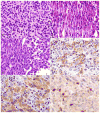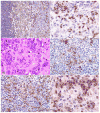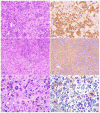The histopathologic and molecular basis for the diagnosis of histiocytic sarcoma and histiocyte-associated lymphoma of mice
- PMID: 20472805
- PMCID: PMC3407882
- DOI: 10.1177/0300985810363705
The histopathologic and molecular basis for the diagnosis of histiocytic sarcoma and histiocyte-associated lymphoma of mice
Abstract
Histiocytic sarcoma (HS) and histiocyte-associated lymphoma (HAL) of mice are difficult to distinguish histologically. Studies of multiple cases initially diagnosed as HS or HAL allowed us to define HS as round, fusiform, or mixed cell types that were F4/80+, Mac-2+, and PAX5-; that lacked markers for other sarcomas; and that had immune receptor genes in germline configuration. Two other subsets had clonal populations of lymphocytes. The first, HAL, featured malignant lymphocytes admixed with large populations of normal-appearing histiocytes. The second appeared to be composites of lymphoma and HS. Several cases suggestive of B myeloid-lineage plasticity were also observed.
Conflict of interest statement
The authors declared that they had no conflicts of interest with respect to their authorship or the publication of this article.
Figures




Similar articles
-
Fine needle aspiration cytology of histiocytic sarcoma with dendritic cell differentiation: a case of transdifferentiation from low-grade follicular lymphoma.Diagn Cytopathol. 2015 Aug;43(8):659-63. doi: 10.1002/dc.23285. Epub 2015 May 21. Diagn Cytopathol. 2015. PMID: 25993973
-
Histological and Immunohistochemical Features of Normal Histiocytes and Langerhans Cells, and Histiocytic Sarcomas in Four-Toed Hedgehogs (Atelerix albiventris).J Comp Pathol. 2020 Jul;178:32-40. doi: 10.1016/j.jcpa.2020.06.009. Epub 2020 Jul 30. J Comp Pathol. 2020. PMID: 32800106
-
Clonally related histiocytic/dendritic cell sarcoma and chronic lymphocytic leukemia/small lymphocytic lymphoma: a study of seven cases.Mod Pathol. 2011 Nov;24(11):1421-32. doi: 10.1038/modpathol.2011.102. Epub 2011 Jun 10. Mod Pathol. 2011. PMID: 21666687 Free PMC article.
-
Extranodal histiocytic sarcoma in a child with acute lymphoblastic leukemia: Cytomorphological features of a rare entity with brief review of literature.Indian J Pathol Microbiol. 2018 Apr-Jun;61(2):278-280. doi: 10.4103/IJPM.IJPM_67_16. Indian J Pathol Microbiol. 2018. PMID: 29676378 Review.
-
Histiocytic Sarcoma: Review, Discussion of Transformation From B-Cell Lymphoma, and Differential Diagnosis.Arch Pathol Lab Med. 2018 Nov;142(11):1322-1329. doi: 10.5858/arpa.2018-0220-RA. Arch Pathol Lab Med. 2018. PMID: 30407858 Review.
Cited by
-
Mouse-Derived Isograft (MDI) In Vivo Tumor Models I. Spontaneous sMDI Models: Characterization and Cancer Therapeutic Approaches.Cancers (Basel). 2019 Feb 19;11(2):244. doi: 10.3390/cancers11020244. Cancers (Basel). 2019. PMID: 30791466 Free PMC article.
-
Chromosome Condensation 1-Like (Chc1L) Is a Novel Tumor Suppressor Involved in Development of Histiocyte-Rich Neoplasms.PLoS One. 2015 Aug 20;10(8):e0135755. doi: 10.1371/journal.pone.0135755. eCollection 2015. PLoS One. 2015. PMID: 26291700 Free PMC article.
-
The SWI/SNF chromatin-remodeling subunit DPF2 facilitates NRF2-dependent antiinflammatory and antioxidant gene expression.J Clin Invest. 2023 Jul 3;133(13):e158419. doi: 10.1172/JCI158419. J Clin Invest. 2023. PMID: 37200093 Free PMC article.
-
Immunohistochemical Characterization of Sarcomas in Trp53+/- Haploinsufficient Mice.Toxicol Pathol. 2017 Aug;45(6):774-785. doi: 10.1177/0192623317730558. Toxicol Pathol. 2017. PMID: 29046139 Free PMC article.
-
Rare t(X;14)(q28;q32) translocation reveals link between MTCP1 and chronic lymphocytic leukemia.Nat Commun. 2021 Nov 3;12(1):6338. doi: 10.1038/s41467-021-26400-x. Nat Commun. 2021. PMID: 34732719 Free PMC article.
References
-
- Achten R, Verhoef G, Vanuytsel L, De Wolf Peeters C. Histiocyte rich, T cell rich B cell lymphoma: a distinct diffuse large B cell lymphoma subtype showing characteristic morphologic and immunophenotypic features. Histopathology. 2002;40:31–45. - PubMed
-
- Akashi K, Traver D, Miyamoto T, Weissman IL. A clonogenic common myeloid progenitor that gives rise to all myeloid lineages. Nature. 2000;404:193–197. - PubMed
-
- Arber DA, Strickler JG, Chen YY, Weiss LM. Splenic vascular tumors: a histologic, immunophenotypic, and virologic study. Am J Surg Pathol. 1997;21:827–835. - PubMed
-
- Bauer SR, Holmes KL, Morse HC, III, Potter M. Clonal relationship of the lymphoblastic cell line P388 to the macrophage cell line P388D1 as evidenced by immunoglobulin gene rearrangements and expression of cell surface antigens. J Immunol. 1986;136:4695–4699. - PubMed
-
- Carrasco DR, Fenton T, Sukhdeo K, Protopopova M, Enos M, You MJ, Di Vizio D, Nogueira C, Stommel J, Pinkus GS, Fletcher C, Hornick JL, Cavenee WK, Furnari FB, Depinho RA. The PTEN and INK4A/ARF tumor suppressors maintain myelolymphoid homeostasis and cooperate to constrain histiocytic sarcoma development in humans. Cancer Cell. 2006;9:379–390. - PubMed
MeSH terms
Substances
Grants and funding
LinkOut - more resources
Full Text Sources
Medical

